Devils place at Masters, advance to state meet

— Page B6
— Page B2


— Page B6
— Page B2
Hundreds of Cal Poly Humboldt students and campus community members protest at the campus quad on Feb. 8. against a housing policy change that left continuing students unsure where they would live next semester.
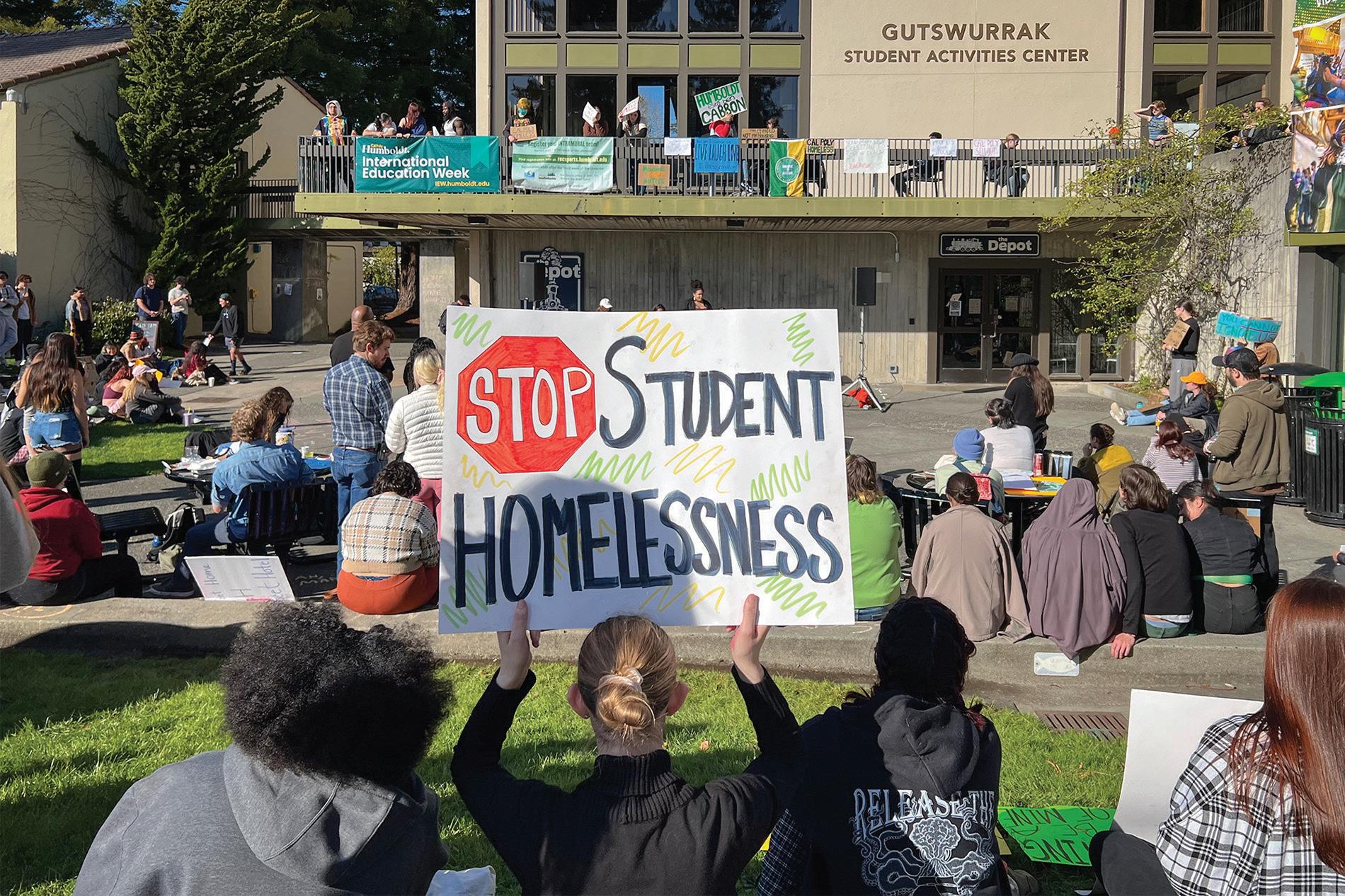
Oden TaylOr/ CalMaTTers phOTO

The Yolo County Board of Supervisors voted Tuesday to accept a state grant of $8.78 million for construction of a new library in Walnut Park in South Davis.
When students decide to attend Cal Poly Humboldt, they likely see themselves living in the forest among the state’s largest redwood trees, high enough on a hill that they can see Humboldt Bay and the ocean in the distance. They probably don’t picture studying from a motel or a floating barge. But that could be the reality
for hundreds of returning students next academic year as the university prepares for an influx of enrollees drawn by its recent transformation from Humboldt State to Northern California’s first polytechnic university. When the university revealed Feb. 4 that incoming first-years would have priority for all oncampus housing — likely locking out returning students — the move sparked protests, a
petition, and the founding of a new organization, Cal Poly Homeless, to fight the change.
In response to the backlash, Cal Poly Humboldt partially walked back its plans, saying it will now find on-campus beds for about half of the estimated 1,000 returning students who were set to be displaced from the 5,700-student campus. But the uproar illustrates how central student housing has
become to just about any major higher education initiative in California, where skyrocketing housing prices have students living in cars and state lawmakers have set aside more than $2 billion over the next few years to build new dorms and on-campus apartments.
The university became a
See GROWING, Page A4




Yolo County’s local COVID-19 emergency declarations will end on Feb. 28 — nearly three years after they were enacted — but that doesn’t mean the virus itself has gone away, the county’s health officer said Tuesday.
In fact, said Dr. Aimee Sisson, wastewater levels of the virus in Davis are moderate and rising, likely driven by XBB.1.5, a “highly infectious Omicron variant (that) is now dominant in California, representing 70 percent of new COVID-19 cases.”

But those levels are well below what was seen during their peak in December,
and other metrics used to evaluate community transmission also remain low, including COVID-19 hospitalizations.
Meanwhile, said Sisson, “as we consider ending the local COVID-19 emergency declaration, it’s helpful to reflect on how far we’ve come since the COVID emergencies were declared at the local, state and federal levels in March of 2020.
“In March 2020, the world was turned upside down by a novel coronavirus that we knew nothing about, for which the only testing available was through the CDC and took days to get results, for which there was no vaccine,
nor any specific treatment, and we didn’t have enough gowns, masks, gloves or goggles to protect healthcare workers, let alone masks for the general public.
“Contrast those dark early days of the pandemic with today’s COVID-19 reality,” she said. “We’ve learned a lot about (the virus). Antigen tests are widely available and provide results in 15 minutes; safe and effective vaccines are available; safe and effective oral treatments available; and we have enough PPE for healthcare workers, along with high quality masks for the general public.
See COVID, Page A5
The two supervisors representing Davis — Lucas Frerichs and Jim Provenza — were joined by Supervisors Gary Sandy of Woodland and Angel Barajas of the rural 5th District in voting to accept the award (which comes with a 100 percent local match requirement) while Supervisor Oscar Villegas of West Sacramento abstained after expressing concerns about remaining funding gaps for both construction and operations.
Since the county received that grant in October, city and county officials have identified several funding sources to help close a remaining $12.7 million gap for construction after accounting for the state grant.
Those sources include $3.1 million in library development impact fees as well as $5.68 million in Mello Roos Special Library Taxes generated in See LIBRARY, Page A5


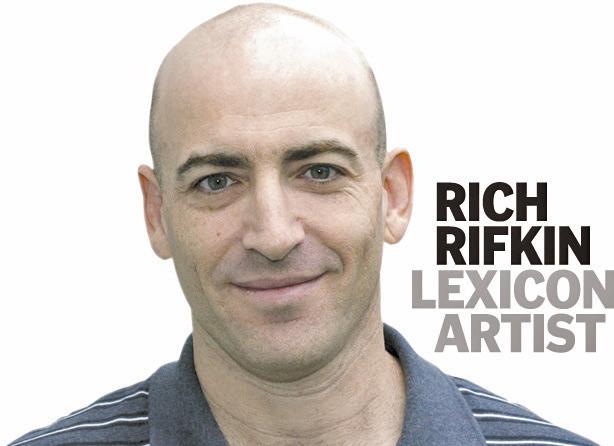 By Karen Nikos-Rose Special to The Enterprise
By Karen Nikos-Rose Special to The Enterprise
Bicycles whirr by, students rush to class, staff and faculty are grabbing lunch or coffee on the go — and sheep graze the grassy knolls among the traffic, bleating every now and then. The grazing is their job.
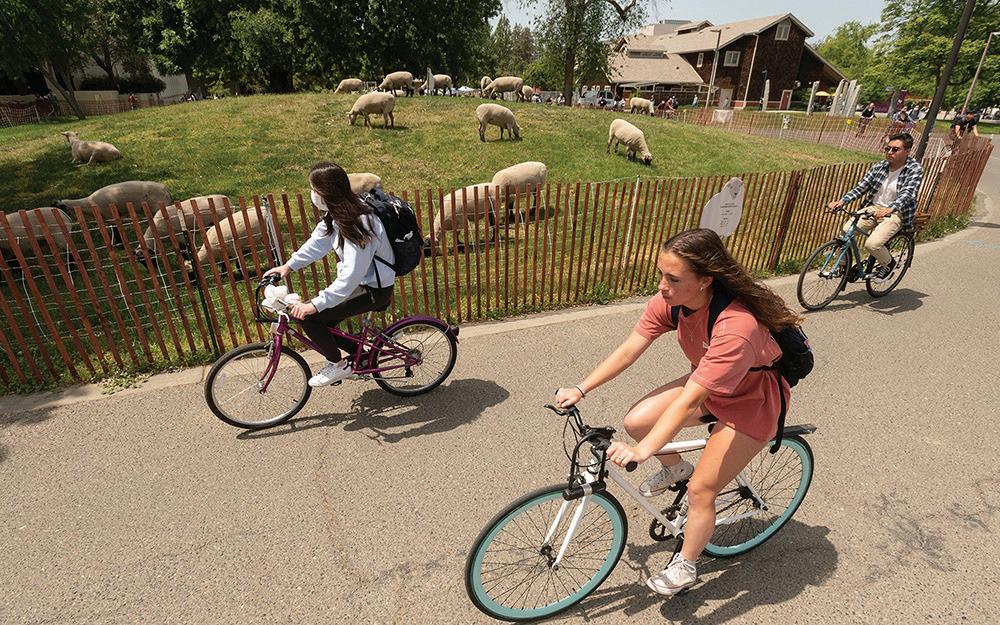
The 25 wooly sheep who seasonally — for the past two years — leave their UC Davis barns to nibble on lawns at various central campus locations, are doing much more than mowing, fertilizing and improving the ecosystem. The sheep also are improving people’s mental health.
The sheep — four breeds of Suffolk, Hampshire, Southdown and
Dorset — first took on this role in 2021, when COVID-19 masking and social-distancing protocols were in full swing. The goal was to determine whether sheep could benefit urban lawn landscapes and make a case for increasing their usage. The program is growing and exploring additional benefits sheep provide.
“This started out as experiment to test their mowing abilities, and we have now published research on how they make people feel peaceful,” said Haven Kiers, the lead author of a new study, director of the sheep mowers project
See SHEEP, Page A4
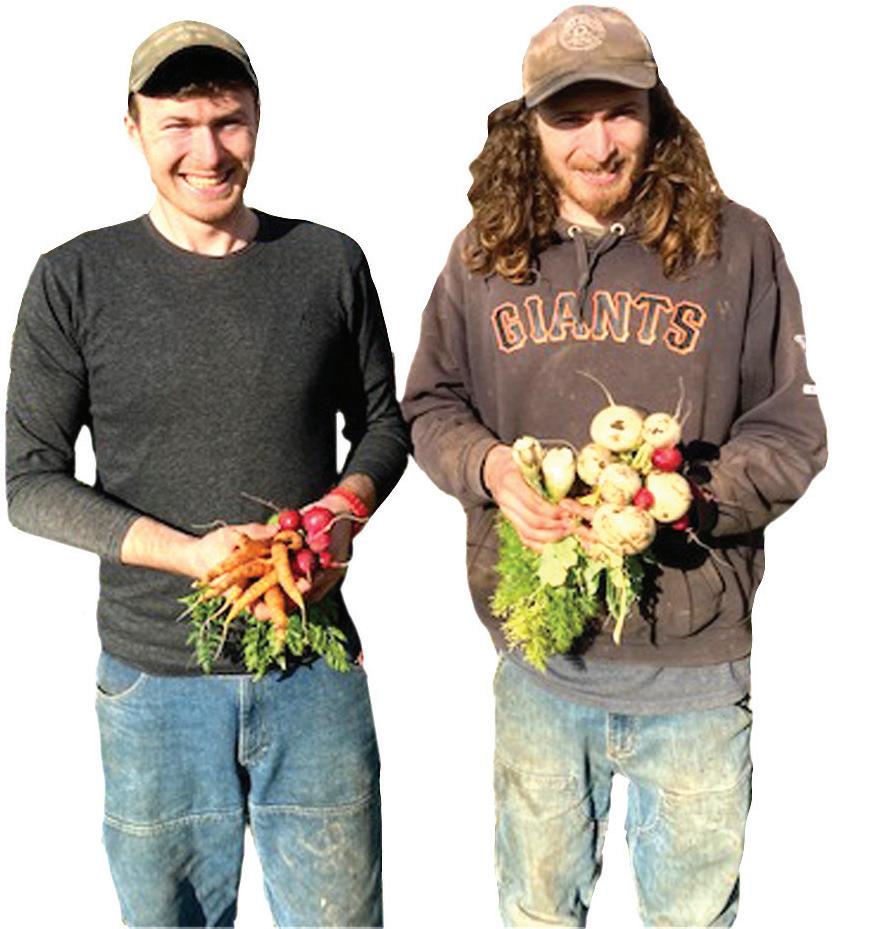
When things go wrong, try to learn from mistakes
The Davis Enterprise is published Wednesdays, Fridays and Sundays by The Davis Enterprise Inc., 315 G Street, Davis, CA 95616. Application to Mail at Periodicals Postage Prices is Pending at Davis, CA.




POSTMASTER: Send address changes to to The Davis Enterprise, P.O. Box 1470, Davis, CA 95617-1470. Phone 530-756-0800
R. Burt McNaughton Publisher Sebastian Oñate
Editor Shawn Collins Production Manager Louis Codone Advertising Director Bob Franks
So Nikki Haley, in declaring her candidacy for President of the United States the other day, said, “In the America I see, the permanent politician will finally retire.”
Fair enough, given that Haley herself is nearing “permanent politician” status and must be talking about the person she sees in the mirror every morning.
“We’ll have term limits for Congress,” she added.
She apparently doesn’t realize that we already have term limits. Last time I checked, members of the House of Representatives are limited to a term of just two years.
When those two years are up, they have to face the voters again. And who better to decide whether they stay or go than the voters themselves?
I’d rather that the voters decide to kick someone out of office than to have them forced out by some artificial deadline that has nothing to do with whether or not they are doing a good job.
Finally, and this may be her entire platform between now and the Republican convention in 2024, in the America she envisions, there will be “mental competency tests for politicians over
75 years old.”
That last little gem was met with raucous applause and shouts of approval among those in the hand-picked crowd at her announcement.
Of course, those in the crowd who are over 75 were cheering because they clearly are not mentally competent enough to understand she was talking about them.
So here’s the plan, carried out to its logical conclusion. Today we ban mentally “incompetent” politicians over 75 from running for office, tomorrow we ban mentally “incompetent” citizens over 75 from voting for anyone or anything.
She is, of course, right. We cannot have mentally incompetent people over the age of 75 running the country. After all, the second you turn 75, you are suddenly
closer to 100 than you are to 50. And closer to 110 than you are to 40. Do we really want 110-yearolds trying to stare down Vladimir Putin, who is apparently permanently just 70 years old?
Then again, we cannot have mentally incompetent people under the age of 75 running the country either.
It’s not the age we should be worried about, but the competence. For instance, George Santos claims he is just 34, but birth records show he is actually 102.
Right or wrong, what Haley and her advisors don’t seem to realize is there are more Republicans over the age of 75 than there are Democrats, and no one over 75 is happy about what she said, including 76-yearold Florida retiree Donald J. Trump.
Yet to be determined in Nikki’s World is who, exactly, will administer these mental competency tests to politicians over 75, the Republican National Committee?
And do Supreme Court justices count as “politicians” or do they get to escape scrutiny altogether?
Another question yet to be answered is what happens if the Mental Fitness Committee decides
someone is incompetent to perform the job? Are they therefore banned from running for office or are they simply branded as “mentally unfit” as some sort of warning label for voters, maybe even with an asterisk next to their names on the ballot signifying their incompetence.
I’m all with you, Nikki, but these things need to be ironed out before we start putting people’s brains on the examining table.
While we’re at it, we may as well throw physical competency into the mix. In other words, can the president board Air Force One without tripping on her shoe laces and breaking her nose, a sure sign of weakness for all the world to see. Is she agile enough to dodge reporter’s questions?
And finally, what about moral competence? Will there be a test for that as well?
I mean, would you rather have a mentally incompetent but thoroughly moral person in office or a mentally competent but thoroughly immoral person in office?
I say, have the voters do the examination and let the chips fall where they may.
— Reach Bob Dunning at bdunning@davisenterprise.net.
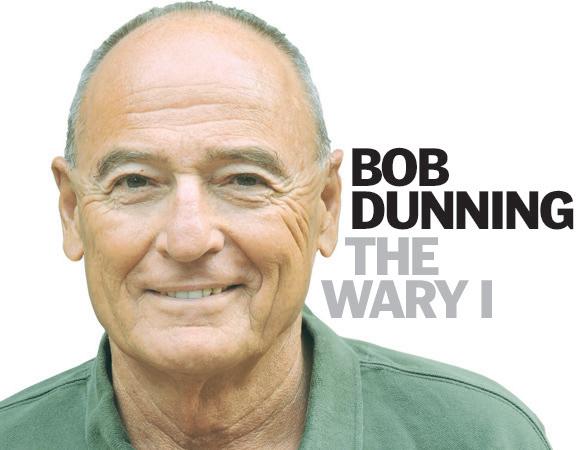

Three major traffic incidents snarled Yolo County roadways during the threeday holiday weekend.
A motorcyclist was killed Saturday night after colliding with a car on Interstate 80 near the Mace Boulevard exit in Davis.
According to the California Highway Patrol, the 37-year-old motorcyclist was traveling westbound “at a high rate of speed” and struck the left rear of a Honda Civic at about 6:40 p.m. He sustained fatal injuries after being ejected from his motorcycle.
Yolo County coroner’s
officials identified him as Dale Joseph Lorenzo Ramirez, a Fairfield resident.
The CHP shut down the westbound lanes for several hours to conduct its investigation, backing up traffic to the Yolo Causeway at one point. The driver of the Civic, a 25-year-old Davis man, was not injured and remained on scene.
A second westbound I-80 crash snarled traffic at about 8:30 a.m. Sunday morning on the Yolo Causeway. CHP Officer Rodney Fitzhugh said a driver traveling more than 100 mph rear-ended another vehicle, triggering a spinout that blocked the
freeway but caused no injuries.
Alcohol also was suspected to be a factor in that collision, Fitzhugh said.
Less than 12 hours later, shortly after 8 p.m., the CHP responded to a fivevehicle crash in roughly the same area that ultimately involving five vehicles in which motorists sustained
minor injuries.
On Monday, a vehicle collided with a tractor on in the 2000 block of Old River Road between Interstate 5 and West Sacramento.
The CHP’s traffic information website indicated one of the vehicles veered down an embankment in the 4:05 p.m. collision, and
that the wreck caused a fuel spill on the roadway.
At least one person sustained major injuries in the crash, which resulted in the closure of Old River Road during the investigation.
— Reach Lauren Keene at lkeene@davisenter prise.net. Follow her on Twitter at @laurenkeene
n The UC Davis Arboretum hosts a Folk Music Jam Session from noon to 1 p.m.
Folk musicians can bring their acoustic instruments and play together informally during this jam session at Wyatt Deck (next to the redwood grove).
Short-term parking is available in Visitor Lot 5 on Old Davis Road at Arboretum Drive. Hourly rates start at $1.75.
n Kerry Loux from the city of Davis will join a public forum on the city’s Climate Action and Adaptation Plan at 11:15 a.m. at Davis United Methodist Church, 1620 Anderson Road. Loux is a sustainability coordinator for the city of Davis and project manager for CAAP. The Final Draft CAAP document and other information is available at https://www.cityofdavis.org/sustainability/
2020-climate-actionand-adaptation-plancaap. Of special note, the Overview and Context for the CAAP on Pages 11-12 are useful information in advance of the discussion.
n Sunday, Feb. 26:
The Davis Odd Fellows’ Classic Film Festival continues with the blockbuster comedy, "The Russians Are Coming, The Russians Are Coming." The films are presented on the big screen in the spacious Upper Hall of the Lodge, 415 Second St. in downtown Davis. The general public is invited, and there is no admission charge (although donations in support of classic films are accepted at the door). Doors open at 6:29 p.m. and the program begins at 7:01 p.m. Enterprise film critic Derrick Bang will give a short talk about this film.
As Los Angeles celebrated the life of beloved mountain lion P-22, mountain lion mortality maps from UC Davis show that many cougars face a similar fate along California’s roads and highways.
The maps, created by the UC Davis Road Ecology Center, reveal that one or two mountain lions were killed every week on California roads and highways between 2015 and 2022. View all maps at roadecology.ucdavis.edu.
That number has decreased gradually over the past seven years, although whether that is due to declines in the mountain lion population itself or other factors is unclear. A statewide mountain lion population estimate is currently pending, and scientists are working on survival estimates to illuminate these questions.
“We do know that, over time, extra mortality from cars, especially for small, isolated populations, adds significantly to the threats they already face,” said Fraser Shilling, director of the UC Davis Road Ecology Center. “The tenacity of P-22 in life and the final tragedy of his death from a vehicle collision highlights the plight of mountain lions throughout California, constantly under threat from traffic while living their natural lives.”
The maps show that Southern California and the Bay Area host the most dangerous roads for mountain lions, with local extinction becoming more likely each year. Particularly problematic highways include:
n I-280, south of San Francisco
n I-15, south of Temecula
n I-5 in Siskiyou County
n SR 74 (Ortega Highway) in the Santa Ana Mountains

Special to The Enterprise
The Yolo County Women’s History Month Committee is excited to announce their 2023 celebration honoring Women’s History Month at the Gibson House grounds from 11 a.m. to 1 p.m. Saturday, March 18.
The theme of this year’s celebration is “Celebrating Women Who Tell Our Stories,” recognizing women, past and present, who have been active in all forms of media and storytelling including print, radio, TV, stage, screen, blogs and podcasts. The timely theme honors women in every community who have devoted their lives and talents to producing art, pursuing truth, and reflecting the human condition decade after decade.
Guest speakers for the event are Winters residents Gloria Lopez — author of “An American Paella,” a compilation of Spanish immigrant stories — and Corinne
Martinez, whose family stories are included in the book. They will prepare paella on site for guests as well as share their experiences and excerpts from the book.
Admission to the program is $20 per person; that includes small tasting portions of paella, tapas and tortillas Españolas.
The Yolo County Library and Archives, local historical societies, the Woodland Public Library, and UC Davis Library Special Collections will also participate.
To make a reservation, visit www.ycwhm.org to register through Eventbrite.
For general information about the committee or the celebration, contact Louisa R. Vessell at 916451-2113 or email at lvessell@sbcglobal.net or visit www.ycwhm.org
Proceeds from the event will benefit the public libraries and women organizations in Yolo County.

Mountain lion expert Winston Vickers, a UC Davis School of Veterinary Medicine wildlife veterinarian, contributed data used in the maps’ creation.
“Regionally, parts of Southern California are especially dangerous for mountain lions, with traffic being the primary cause of death,” Vickers said. “In other areas, direct conflict with livestock results in mountain lions being killed. The two together are clearly bad, especially for small, isolated populations. Busy freeways also cut off mountain lions from potential mates, severely decreasing their genetic diversity and threatening their existence.”
P-22 was a wild mountain lion who became a Hollywood legend. He lived most of his 12 years in Griffith Park, where his image was famously captured walking beneath the Hollywood sign.
Throughout his life, he evaded
Ronald Dean Clift

March 5, 1948 — Feb. 10, 2023
Ronald Dean Clift, 74, lost his battle to congestive heart failure, and passed away on Friday, Feb. 10, 2023, at his home in Davis with his wife by his side.
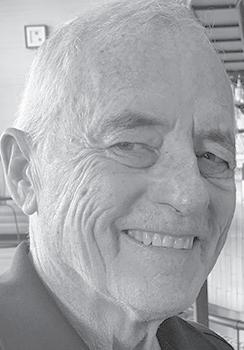
Ron was born on March 5, 1948, in Alamogordo, N.M, and was the son of a career Air Force father. As his dad was transferred, Ron lived in Paris, France; Italy; Midwest City, Okla.; Rapid City, S.D.; Gulfport, Miss.; and small towns in Montana. When his dad retired in Davis in 1963, Ron attended Davis High School, where he played football and graduated in 1966. After, he went to UC Davis for two years. Ron learned how to code and worked as a manager for EDs and ended his career in technology working for HP.
Ron was an amazing football player and wore his No. 21 for the Blue Devils proudly. In 1965, Ron made a game-winning run
traffic, becoming the first known mountain lion to successfully cross the 405 and 101 freeways before settling in Griffith Park. There, he was cut off from other mountain lions that might continue his legacy.
Instead, his life became a symbol of the need for wildlife crossings and a reminder of wildness in even the most urban settings. His captivating face and story helped raise funds for the world’s largest wildlife overpass — the Wallis-Annenberg Wildlife Overcrossing — which broke ground last April to create a corridor between the Santa Monica mountains and areas to the north.
P-22 was hit by a vehicle in December 2022. Already weakened before the collision by old age and other illnesses, he was euthanized on Dec. 17 because of health issues including kidney and heart disease, chronic weight loss and a parasitic skin infection.
that allowed the quarterback to score and beat Woodland High school his senior year. Ron continued his love of sports by becoming an avid golfer. He and his wife would take trips all over the country to play on the best golf courses. Ron’s humor was contagious.
He continued interacting with others in the community by going to all his favorite restaurants, and getting to know the workers at Crepeville, Cattlemens, Paesano’s, Tres Hermanas and Café Bernardo. Ron and Donna were together for 40 years and married for 39 years.
Ron is survived by his wife Donna Clift; son Ryan Clift; daughters Korie Martinez and Rachel Clift; granddaughter Elysia Martinez; grandson Carter Clift; nieces Lauren (Clift) French, Anna Clift, Sara (Clift) Fefferman, Danielle Alvarez, Jenelle Alvarez, Elizabeth Peters, Monika
Peters and Claire Peters; nephews Michael Peters and Timothy Peters; brotherin-law Jeff Peters (Kathy); and sistersin-law Cary (Valdrow) Meggers (Jacob) and Cynthia (Peters) Alvarez.
Ron was preceded in death by his parents, Vernon and Eileen Clift, and by brothers Dennis and James Clift.
Ron’s funeral will begin at 2 p.m. Saturday, Feb. 25, at the Davis Cemetery, with a celebration of his life immediately following at Tres Hermanas. Those who wish to sign a guestbook online may do so at www. smith-funerals.com

polytechnic campus last year, receiving more than $450 million in state funds to add new STEM courses with a focus on environmental sustainability and to build the infrastructure to support them. Enrollment is expected to grow by 50% in the next three years and double by 2029. Already, the university has received more than 19,000 applications for fall 2023, nearly twice as many as for fall 2022.
The state funds will help pay for the new off-campus Craftsman Mall housing complex, projected to open to about 1,000 residents in fall 2025. New on-campus housing, along with a parking structure, will house another 600 to 700 students - but that won’t open until summer 2027, the university says.
“I think our transition has been really fast, and we’re starting to see the effects of not planning properly for the influx of additional interest,” said Juan Giovanni Guerrero, the president of the university’s student government.
Cal Poly Humboldt currently has enough on-campus housing for a little more than one-third of its students — more than some campuses in the Cal State system, where many students commute. A 2018 study found nearly one in five of the university’s students had experienced homelessness, twice the Cal State system average.
The university says it has been “looking into many creative solutions” to bridge the gap until new housing is built, and has signed contracts with three local
hotels — the Comfort Inn, Motel 6 and Super 8 — about three miles from campus to provide a total of 350 beds. Administrators also said they are considering housing students in “floating apartments or studios.”
Eureka City Manager Miles Slattery confirmed that the city has been discussing logistics for parking a barge in Humboldt Bay, and identified it as the Bibby Renaissance, which can house as many as 650 guests and crew members. The “floating hotel” is often used to shelter workers in remote locations. An online virtual tour shows spartan bedrooms, a gym and a roof terrace.
During the COVID-19 pandemic, housing students in hotels became a temporary solution to overcrowding and housing insecurity, including at a number of University of California campuses. Cal Poly Humboldt has housed more than 100 upperclassmen at the Comfort Inn since 2022.
But Cal Poly Humboldt students have said the hotel plan compromises their safety because it puts them in close contact with homeless people in the local
community who may be mentally ill, doesn’t guarantee access for disabled students and places students of color and LGBTQ students in areas where they’re likely to experience bigotry.
Last week, hundreds of Cal Poly Humboldt students and community members gathered in the campus quad to hear hours of testimony from students affected by the change. Students set up tents and cardboard boxes to symbolize the housing options they are facing.

“The school made this decision without talking to any students. They just decided, ‘Hey, we’re gonna send all of the students to motels,’ and so we want to make sure that we are the ones involved in this decision,” said Annabel Crescibene, a sophomore involved with Cal Poly Homeless. The new organization has set up an Instagram account and plans to create a podcast for students to share their housing woes.
While Cal Poly Humboldt’s student body is only 45% white, the surrounding town of Arcata is 69%
white. In 2018, after Black Humboldt State student David Josiah Lawson was killed at an off-campus party in a case that is still unsolved, the Eureka NAACP called on the university to stop recruiting students of color until conditions were met to ensure their inclusion and safety.
Some students of color and LGBTQ+ students at last week’s protest recounted facing racism and homophobia while offcampus.
Senior Daniel Garcia said he tries to avoid going off campus due to the racism he faces in the community. When his mother visits him and they spend time in the town of Arcata, he said, they often experience staring and hostility, and overhear people using discriminatory language.
At a pizza restaurant one night, he overheard several men saying racial slurs, he said.
“They were drunk, and I called them out in a way subtly, and the energy was really hostile,” Garcia said. He later heard that another student had been beaten up after asking a group of men to stop saying the N-word, and wondered if it was the same group. Students involved in Cal Poly Homeless are demanding that all housing both on and off campus be safe and accessible — including resolving mold problems that some students have reported in the dorms — that transportation be provided, and that the university increase amenities in off-campus housing and lower the cost.
Some students and parents are also calling for a cap on admissions until the infrastructure is built to support a larger campus population.
From Page A1

and an assistant professor of landscape architecture in the College of Agricultural and Environmental Sciences.
“I can’t believe this is research; it’s so much fun,” Kiers said.
The research has important relevance, especially at a time when, nationwide since the 1980s, students of all ages have expressed that they struggle with stress and their mental and physical health. Kiers, co-authors and researchers surveyed about 200 students, staff, faculty, and community members about their experiences walking by, or even hanging out in Adirondack chairs studying, sketching and painting watercolors among the sheep.
“We found that there was a significantly lower likelihood of current feelings of being ‘very stressed’ or ‘stressed’ among the sheep mower group when compared to the group that did not experience sheep mowers,” she said of the study, researched over four sheep-mowing events in spring 2022. “The group with the sheep was just so much happier,” Kiers said.
She said as far as she knows, similar stress studies have been done only with dogs and horses, not sheep. “We really need to look at how we can get the most out of landscape management, in all forms — in the physical environment as
well as mental health.”
The paper, co-authored with Carolyn S. Dewa, of the UC Davis Department of Public Health, and Kelly M. Nishimura, a 2020 graduate of UC Davis and urban designer in the Office of Campus Planning and Development, was published in January in The International Journal of Environmental Research and Public Health.
Students and other passersby participating in the experiment were interviewed by student employees and student shepherds in quick chats near the sheep and on social media. All the while, the sheep are given access to plenty of clean water, are fenced in with a combination of electrical and snow fencing, and are trailered back and forth to their home barns in the morning and at night.
Researchers collected comments from observers, then aggregated the comments into themes that included community engagement, place identity, relaxation and academic stress reduction.
Mina Bedogne, a research assistant on the project and now in her fourth year of undergraduate work, said the distraction seems to make most people happy.
“Just taking a break from a chaotic workday and mindlessly observing the flock has brought joy to so many,” said Bedogne, an environmental science and management major.
— UC Davis News
Davis and surrounding areas like El Macero and Willowbank.



Other possible funding sources include county American Rescue Plan funds as well as capital improvement reserves.
Additionally, the Davis City Council earlier this month pledged up to $1.5 million for the project, with those funds possibly coming from the city’s own ARP funds that were set aside for climate resilience (a new library could also serve as a climate resilience hub) and from park development impact fees. The city previously committed to providing the land itself in Walnut Park — land valued at an estimated $4 million.
“Staff plan to continue to explore funding contributions from the city and (Davis Joint Unified School District), review any additional grant opportunities, explore community fundraising and then look to county funding sources … to close the remaining capital gap,” according to the staff report prepared for Tuesday’s meeting.
But even if the full construction budget is covered, how to fund library operations in South Davis remains an issue.
Based on an assessment by county staff, it would cost an estimated $1.1 million to operate a South Davis Library annually beginning in 2026. The cost could be reduced by reducing services and hours at the site.
Among the options provided by staff for covering operational costs:
n Reducing services at other
libraries to staff the new South Davis library.
n Reducing county General Fund departments and programs by a corresponding amount to fund a new library.
n Obtaining city of Davis and Davis Joint Unified School District commitments to provide ongoing support to the library.
n Considering a ballot measure to increase the Library Special Tax to be able to operate the facility.
“Staff do not recommend the first two options,” the report said.
“The third option has been discussed on and off with the two partner agencies. However, other than the land and the capital contribution that the city has committed to provide, no ongoing financial support has been pledged at this time by either agency. As a result, staff believe the board should consider an increase to the Library CFD Special Tax Measure, or other revenue measures, that allow voters/ community to determine whether they would support operations and maintenance of a new South Davis Branch Library.”
Davis residents and those living in surrounding communities currently pay a library parcel tax approved by voters. In 2022, the tax was $116 per single-family residence (as well as for agricultural and commercial parcels) and $58 per unit for multi-family parcels.
If the board wanted to raise an additional $1 million per year to fund a South Davis Branch Library, county staff reported, that would require an increase in assessment of approximately $45
to $60 for single-family homes and $22 to $30 for multi-family units per year.

Such a tax proposal could be placed on the ballot as soon as the March 2024 primary election, but a special election could be called before then as well.
The tax increase would have to be approved by two-thirds of voters to take effect.
Provenza expressed confidence that voters would approve a tax increase, citing the historical support for library parcel taxes in Davis.
“I have faith in the Davis community… that we will succeed,” he said. “We have succeeded on virtually everything, whether it was schools or libraries in the past. In fact, the past measure was to fund services at the Mary Stephens Branch and South Davis. Now a little more is needed to make this possible, and I have no doubt we will succeed in that.”
Villegas responsed that, “I have no doubt either. I think the history shows that the Davis community has absolutely stepped forward when it comes to these types of projects, especially when it comes to libraries.”
However, he later said, “this is a big ask, and this is a big ask of a community that has always supported its libraries… these are difficult times and it’s hard to expect that the voters would act in the way that they historically have.”
Should Davis voters not support a tax increase, he noted, “there is a prospect that we would build it and nobody could come because we can’t open the doors. There isn’t that ability to pay for
the ongoing costs. I’ve heard a little bit of … what seems like kicking that can down the road to see whether or not there’s a path by which we do that.”
Villegas said he wanted to minimize the county’s responsibility “in the event that the community doesn’t step up and say, ‘Hey, yes, we want this library and we’re willing to find a way to pay for it.’”
Chad Rinde, the county’s chief financial officer, noted that the county library system can adjust the level of service to fit the funding.
“The county can start with a lower level of service for this new facility and then continue to work to raise that level of service over time. That is one lever that is within our control,” he said.
Additionally, the county could call for a special election early to determine the support of Davis residents, Rinde said, “so you’re not going to a construction award without clarity.”
Frerichs acknowledged the concerns about ongoing operational costs, but said, “I also think that the Davis community has previously demonstrated its willingness to step up and fund its branch of the Yolo County Library and I think that the community will do so again when given the opportunity to help out…”
Added Provenza: “We could be timid or we could be bold. We will not get another grant.”
“We will fund this with a tax measure. But if we turn it down, that grant disappears and any ability to build this library or any library in the foreseeable future in
Yolo County goes away.”
“We’ve got the money to build this thing, we’ve got the land, and we will operate,” Provenza said.
Plans for a library in South Davis have been in the works for years.
According to county staff, prepandemic data showed that the services, resources, and programs offered at the Stephens Branch Library in North Davis were at capacity, with data from 2018 showed high usage of the library with frequent use of meeting rooms and parking spaces.
“Ultimately, this data coincides with the experience of staff that often find individuals crowding at tables or sitting on the floor,” the staff report noted.
The library has also reached maximum capacity in terms of space.
“In line with this and consistent with a long-term community vision, constructing a new library in South Davis is the predominant strategy to reduce library facility capacity issues, expand services to a growing Davis community, and provide access for those who have difficulty traveling to the Mary L. Stephens library in North Davis,” the staff report noted.
“This opportunity is unique and benefits the entire community as it can both mitigate the overflow and potentially serve new community members who previously faced geographic barriers to library access as well as expand the overall collection of the county library system.” County staff will return to the board at a later meeting with updates on funding.
From Page A1
“We are in a very different place than we were in March of 2020 and one where it is appropriate to consider ending the COVID-19 emergency,” said Sisson.
That’s exactly what the Board of Supervisors decided to do on Tuesday,
voting unanimously to end the emergency declarations on Feb. 28, the same day Gov. Gavin Newsom has said the state health emergency will end.
However, Sisson said, “COVID-19 is still here and Yolo County public health continues to address the virus.”
The county will continue
to stock its five outdoor vending machines with free antigen tests and free vaccinations will continue at county-run clinics and through the home vaccination program.
“But this will end when public health no longer receives no-cost vaccines from the federal government,” Sisson warned.
And with the federal government planning to end its COVID-19 emergency on May 11, universal coverage of testing, vaccination and treatment will end “and the (United States) will return to our broken system of coverage based on insurance status,” said Sisson.
Going forward, the
county’s public health department will continue to support congregate settings with outbreak prevention and response resources, she said, “especially our vulnerable residents in longterm-care facilities.”
Additionally, the state requirement for masking in healthcare, correctional
and shelter settings is not connected to California’s state of emergency declaration and will continue beyond Feb. 28.
“Similarly, as local health officer,” Sisson said, “I retain the authority to control the spread of communicable disease in Yolo County without an emergency declaration.”
The Hattie Weber Museum celebrates Black History Month with a new exhibit, "Davis Bus to Alabama 1965."
Eleven photographs present the story of 34 Northern Californians who answered Martin Luther King, Jr.'s call for supporters of AfricanAmerican voting rights to join his protest march, which had started in Selma and would end in Montgomery, the state capital.
On March 21, 1965, 27 of them, from Davis and Woodland, boarded a chartered bus at Davis Community Church.
Seven more would join at a stop in Sacramento.
Gerald Friedberg, a UCD professor, took the photos in the exhibit.
They show the group boarding the bus, three days later standing along the highway watching for King and his marchers, joining them for the final 15 miles, and the next day, marching through the city's neighborhoods to meet Gov. George Wallace at the Capitol. The presence in several photos of helicopters and National Guardsmen reminds us that the possibility of encountering violence was a constant concern.
Copies of short accounts of the experience, by Friedberg and the Rev. Duane Proett (pastor of Davis Community Church in 1965), will be available for those who would like more information. The museum, at 445 C St., is open on Saturdays from 10 a.m. 4 p.m.
Robin Dewey invites voters to her home to meet Francesca Wright, District 3 City Council Candidate, at 49 College Park at 5:30 pm on Thursday, Feb. 23.
Wright will share a bit about herself and listen to concerns and ideas for making Davis a better place to live. Light refreshments will be provided. Additional meeting times and dates are online at WrightforDavis. org. RSVPs appreciated but not required at con tact@wrightfordavis.org.
At their Wednesday, March 1, meeting, the Valley Oak Chapter of the Embroiderers Guild of America will feature a
hands-on lesson in how to make Dorset buttons, a needle-lace button.
Two variations will be taught. The meeting will begin at 11 a.m. in the Flying Needles Quilt Guild's space at the County Fair Mall in Woodland. Kits with the materials, instructions and needles will be provided. Attendees should bring scissors.
Donna Neville’s campaign for Davis City Council, District 3, will host a kickoff event from 2 to 3:30 p.m. Sunday, Feb. 26, at the Central Park Farmers Market Pavilion in downtown Davis.

Neville is running for the city council seat vacated when Lucas Frerichs moved to the Yolo County Board of Supervisors. This event is open to the public and is free to attend. Light refreshments will be served
Just two hours east of Davis in the Sierra Nevada mountains lies the largest alpine lake in North America. The transparent cobalt-blue waters of Lake Tahoe are almost as pure as distilled water. However, over the past 50 years the lake has lost about a third of its clarity.

On the latest episode of “Timeout Radio,” host Rohan Baxi talks to Chris Joseph from Keep Tahoe Blue about the many threats to the lake and what people can do to keep it pristine and clear.
In this episode’s travel segment, listeners will learn about some of the clearest and bluest lakes around the world from New Zealand to Siberia. The episode takes a deep dive into Lake Tahoe where you can kayak in Emerald Bay, hike through Desolation Wilderness, meet a fish called Tessie, and help preserve the natural wonder of this sparking azure Lake of the Sky.
Timeout Radio is a radio show and podcast based in Davis for youths. It airs on KDRT 95.7 FM from 5:30 to 6 p.m. Tuesdays and 8 to 8:30 a.m. Saturdays. All episodes are archived at https://kdrt.org/pro gram/timeout-radio. Follow Timeout Radio on Instagram @timeout. radio and Facebook at @TimeoutRadio.
Special to The Enterprise
The Tuskegee Airmen helped defend the United States during World War II even though as Black Americans they had to overcome Jim Crow laws and deep racism just to be allowed to fight for their country.
On the current edition of the KDRT program “Davisville,” Leigh Roberts and Lanelle Brent — daughters of George “Spanky” Roberts, a fighter pilot and Tuskegees’ commander — talk about what the airmen endured, why they endured it and what they achieved.
“Davisville” appears on Davis station KDRT-LP, 95.7 FM on Mondays at 5:30 p.m., Tuesdays at noon, Fridays at 5 p.m., and Saturdays at 8:30 a.m.

Davis High’s Black Student Union traveled to North Davis Elementary school on Feb. 8 to educate students on Black history.
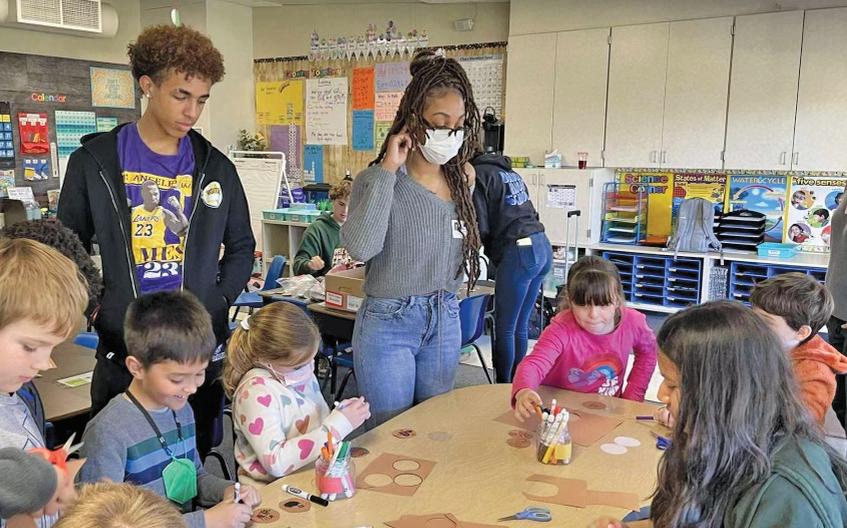
There they discussed how important it is to understand Black history as American history while sharing African American stories and prominent historical figures with the elementary students.
BSU split up in two groups with one group presenting to 2nd graders and the other group to 5th graders.
The BSU was busy with activities like reading stories to North Davis students
and partaking in arts and crafts that were related to African American history.
BSU member Mia Chadwick enjoyed her experience.
“At first we read short stories created by Black authors to incorporate more diversity, while rotating with different groups of students…We then spent time with a lot of the students during their lunch time playing on the blacktop or just sitting down with the students in the cafeteria,” Chadwick said.
In those few hours, young students became more educated on history about Black individuals which gave them more of an insight on what it means to be a
minority and to understand all people are equal.
“As the older generation, the younger generation looks up to us which means we have a responsibility to teach the younger kids. Incorporating Black history (in) the education will make an impact,” Chadwick said.
BSU member Juan Muhirwe believes this change starts locally.
“I think overall this helped end any bias or prejudice towards those of Black descent, and these young kids will eventually be our future generation and if we teach them right early we won’t have to worry in the future,” Muhirwe said.

Black history lessons should be expanded to include the whole African diasporic history instead of limiting what’s widely taught to the trauma of African Americans.
Mainstream Black history lessons consistently restrict the narratives about African Americans to topics like racism, slavery and segregation, and imply that it all ended in unity. In doing so, the dominant narrative glosses over the realities of the true darkness of what was and is done to African Americans and the magnificent greatness of the African Diaspora.
Conservatives and others who struggle with white fragility hold the opinion that talking about true Black history is inappropriate, explicit and forces an agenda. We see this with the fight against teaching critical race theory and the AP African American Studies course in public high schools.
American people seek to protect themselves and their children from the momentary discomfort of facing reality. This lack of accountability by Europeans and their
descendants since chattel slavery and colonization allows this legacy of hatred and systemic oppression to continue controlling the narrative.
Not giving us our full history makes it hard to make connections between what happened during the creation of American society, enslavement, Jim Crow, the civil rights movement and the injustice happening today in our systems and demand accountability. Learning what happened would bring forth a reality that would destroy the already tainted image of white America that those who wrote history books worked hard to build. This changing of the narrative to cover their tracks and avoid accountability is why issues of oppression, persecution, and inequity are still so prevalent in our society
Junior La’Princia Mabins Hally feels that the Black history taught in schools has been oversimplified to what is palatable for white audiences.

“I think (the stories) are made by white people just to seem as if they weren’t as horrible (as they were) and like Black people have a chance. In my research and reading, I saw all the brutal things (that have been) done to black people. Honestly I felt really



The emotions and comfort of white individuals are constantly prioritized over doing the important work needed to deconstruct the systems of white supremacy and rebuild toward unity. Teaching Black history in schools is a polarizing issue. Even within the classroom, there is much backlash when Black people are prioritized.
Most of Black History Month, for example, is spent focused on Martin Luther King Jr. and Rosa Parks because they are more relatable to the broader populace.
However, repeating these stories takes up opportunities to include a greater variety of historical figures taught during the month. Adding more stories can help Black individuals connect with thier culture and keep society from repeating the same mistakes.
Black History Month needs to include the broad African diaspora instead of the limited narrative of African American history. If anyone wants to ally with Black people they can put resistance aside and learn the history. Americans need the opportunity to learn and this cannot be done without proper representation in schools.
Thelma Mothershed
“She was a part (of) the Little Rock Nine, one of the first African American students integrated into allwhite schools. (She) shows me it’s okay to go against the norms ... fighting for what you think is right.”
Charm Blackwell
Sophomore
Colin Kaepernick
“(He) is an African American football player who kneeled for our rights. He changed my life because he (was) saying ‘Don’t let them see us from the outside. We want to show people the inside of us. Don’t just look at my color.’”
Ray Keeper Sophomore
Maya Angelou
“She was a poet, singer, dancer and, most importantly, a civil rights leader ... She influenced me with her poem ‘Phenomenal Woman’ where she talks about how divine and special every woman is as they were created.”
Mariam LeValle Sophomore by ahlaam musa Guest editorialIn order to create a more intelligent name for themselves and eliminate any form of competition, colonialist countries rewrote African history and diluted the greatness of ancient African civilizations.
Kingdoms such as Ancient Egypt and Ethiopia were not portrayed as the strong empires that they were, and their contributions to modern civilizations were either left out of history or attributed to white people. Slavery and the slave trade played a big part in the distortion and erasure of African history. The forced migration of Africans to the western world created a cultural rift between those living on the African continent and those captured and sold into slavery.
This sudden change in environment created a disconnect between Africans and their mother country, eventually leading to misinformation or lack of knowledge about Africa and its history. Descendants of enslaved Africans had little knowledge of their ancestors’ histories, and the little history they were taught was whitewashed, attributing African accomplishments to white colonizers.
The rich history and culture of ancient African civilizations was replaced by false portrayals of uncivilized, savage people, seemingly incapable of any achievements or contribution to modern civilization.
Slave traders and colonizers depicted the Africans as “savages,” in order to make their horrible actions look as though they were for the good of the African people. One issue that Europeans had with this process, however, was the written recollections of Herodotus about his personal interactions with African people. His writings told of the greatness of the Africans and their civilizations.
In order to distort African history without contradicting Herodotus’ writings, Europeans adopted the term “Sub-Saharan Africa” to separate the “civilized” Egyptians and Ethiopians from Africans living below the Sahara desert. They believed that any African living below the Sahara desert was part of the “savage,” “uncivilized” African population, while those living north of the Sahara were light skinned, intelligent almost-Europeans, who were responsible for any contributions to modern civilizations emerging from the African continent. This belief was not true at all, however, and only served to widen the divide between people living on the African continent and those forced into slavery in the west.
Over time, African history has been distorted and diluted to the point where most people imagine Africa as a place without history, that was savage and uncivilized until the Europeans came along. Nowadays, however, people are taking the time to learn more about African history, and the greatness of the African continent and its people is finally being discovered.
— Musa is a senior at Davis High and an intern with The Culture C.O.-O.P.


Multimedia Journalism is an awardwinning Career Technical Education program at Davis High.
Students in the class create content for a schoolwide video show, student newspaper and website, community podcast and weekly page in the Davis Enterprise.
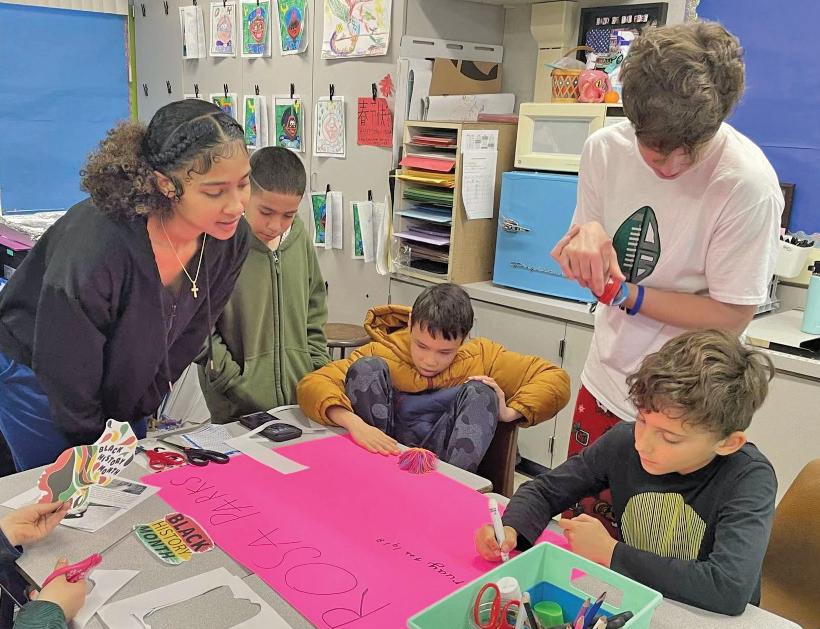
Students who want to join the program can select Multimedia Journalism 1, a yearlong academic elective.
Students who are interested can attend an informational session Feb. 24 in L28 during lunch.

Sen. Dianne Feinstein announced this week that she will not run for reelection, sounding the official starting gun for the 2024 campaign to succeed her in the Senate. As the race gets going, it probably makes sense to ask a fundamental question: What should Californians be looking for in their next U.S. Senator?
Feinstein’s storied career offers some clues.
Look, I’m biased. I had a front-row seat to her tenure in office, and I saw her at her peak. She was a force of nature. She viewed her job as solving problems for the people of California and the nation.
Her Senate colleagues lived in fear that she would buttonhole them on the Senate floor to get them to sign on to one of her priority bills. When she was trying to round up votes, she was relentless. How else do you think she was able to get the 1994 Federal Assault Weapons Ban passed over the virulent objections of the NRA? How else do you think she was able to publish the Senate Intelligence Committee’s torture report over the concerns of the CIA?
Now some may say — and boy, do they — that her time has passed. That at 89 years old, she doesn’t understand the superpolarized politics fueled by cable news and social media bubbles. That may be true.
But Feinstein has a much deeper understanding of California than those pundits and advocates ever will. That’s why she was the state’s most popular politician – with approval ratings above 50% – until just a few years ago.
From my vantage point, it comes down to three things.
Feinstein is many things, but first and foremost she is a passionate advocate for the principles she holds dear. She’s led the fight for reproductive freedoms before, during and after the Roe era. More than anyone else, she has stood up against gun violence and for common-sense gun regulations. She passed legislation to increase fuel economy standards for automobiles and light trucks. She sponsored the reauthorization of the Violence Against Women Act and led the effort to successfully repeal the Defense of Marriage Act (which prevented the federal government from recognizing same-sex marriages) after being one of only 14 senators to vote against it in the first place.
And woe to her colleagues who stood in her way — like Republican Sen. Larry Craig of Idaho who tried to lecture the “gentlelady from California” about the nature of guns and gun violence.
Second, when it comes to fighting for the people of California, you must build alliances – and yes that includes with Republicans. The Senate is a small place. You can’t pass anything of consequence without 60 votes. So on the Lake Tahoe Restoration Reauthorization Act, she worked with Republican Sen. Dean Heller of Nevada to get it passed. On criminalizing cross-border tunnels from Mexico into the United States, she worked with Sen. Jon Kyl of Arizona. And on stopping the accessibility of precursor drugs needed to cook meth, she worked with Sen. Jim Talent of Missouri.
California’s next senator will have to work with Republicans on countless issues important to the state.
Finally, she never lost sight of why the people of California sent her to Washington. It certainly wasn’t to score points on Twitter. The state needs an advocate who will work to stop global warming and fight for dollars to address the state’s water crisis and catastrophic fires; to make sure that there’s someone working day and night to make sure our nation is safe and our economy is strong.

And I recognize, as I hope the new crop of candidates running to succeed her do, that she was a true pioneer and a trailblazer who leaves enormous shoes to fill.
— Scott Gerber is the former communications director for U.S. Sen. Dianne Feinstein and founder and partner of Vrge Strategies. He wrote this for CalMatters, a public interest journalism venture committed to explaining how California's Capitol works and why it matters.

During a break in the rain in late January, I decided it might be nice to get out on my gravel bike. While my friends that day were riding the paved roads north and west of Davis, I opted to steer south solo into Solano County.
On remote Brown Road, heading toward Maine Prairie, I was greeted by thousands of migrating geese noisily landing in a meadow. I was more than 9 miles south of Dixon and found the condition of the road excellent.
I’d been out that way a few times and experienced loose rocks that my tires had sunk into, making it hard to ride and remain upright. This time the gravel was compact, flat and fast.
I continued east and then turned north on Bunker Station Road — so-named for a former stop on the electric Sacramento Northern Railway. Once again I was pleased with the quality of the dense dirt surface.
But the smile was wiped off my face several miles closer to Davis.
I was pedaling back on an unpaved section of Sikes Road — a couple miles before Midway — when the gravel became unridable for me. Rather than pea-sized pebbles, the central surface on that stretch of Sikes is stones the size of my fists, some twice that.
Along the edge of Sikes there were no rocks. So rather than risk the center of the path, I rode on the right in a rut formed by farm-truck tires. Unfortunately, I must have looked askance and did
not realize my front wheel was perilously close to the lip of the 2-inch deep, 10-inch wide groove.
In an instant, I hit the lip and fell over the side of my bike, my shoes locked into the pedals. I saw jagged rocks just before face-planting into them.
I was able to get up and wasn’t immediately in much pain. But I could clearly see and feel red drips of my blood coloring the gray stones below.
Using one of my (unattached) sleeves, I wiped my face and realized I was pretty cut up.
I also had gashes and scrapes on my arms and legs, and was pretty sure one of my fingers — which I’d busted a few times in the past — was broken again. I examined my helmet and saw no marks. Even though my face was bloody, I didn’t have a concussion.
Less than a minute after ramming into the rocks, I saw a rusty old pickup slowly driving toward me on this desolate rocky road. As it bounded in my direction, it looked as if the chunky gravel was too much for that dilapidated Dodge. But eventually, the truck reached me.
I waved, hoping I might get driven home. But as it came to a stop, I could see the bed of
Every ten years, our country conducts the census to get a count of our citizens. Following this process, political district lines are redrawn to ensure that every community has a voice in each level of our government. The last time our state went through redistricting back in 2011, Yolo County was drawn out of my district. This time around, my district once again includes all of Yolo County except West Sacramento.
Yolo County has a strong tradition of excellence, whether in agriculture, education, environmental stewardship, or economic opportunity. Our community is a leader in our state in agriculture with
Speak out President
Sebastian Oñate EditorCA
this pickup was overfull with hay and the cab was cramped with the driver and another farmworker. Upon asking, the Latino laborers told me (in English) my face didn’t look too bad.
“You have a cut here,” the driver said, pointing at the bridge of his own nose.
“Another one here,” indicating above the top lip. “And it’s bloody there and there,” pointing to his cheek and chin.
“You should be OK,” he said.
I thanked him for stopping and the two ranch hands slowly drove north on Sikes toward their destination cattle.
Shortly after they left, I decided I could handle the 15 mile ride home. And then I realized my rear wheel would not move. Uh oh!
Upon examination, I spotted the problem. The quickrelease came loose in the crash, and my wheel was dislodged. It took no time to get the axle in place, tighten the quick-release and get my bike spinning as it should.
Alas, I still had another 1.5 miles to ride on that rugged gravel. So again I stuck to the edge where there were no rocks. When I fell I was riding about 17 miles per hour. I now slowed to 10 mph and hopped off a couple times when it was too challenging to stay in the center of rut.
I could have continued north on Sikes Road another 5.5 miles. But I’d had enough gravel for that day. So I took a paved course back to Old Davis Road — Midway, Robben, Vaughn, Runge and Tremont roads.
hundreds of millions of dollars of agricultural production every year. With UC Davis in our community, we have access to a world-class institution that leads in agricultural research, innovation, and opportunity. UC Davis attracts top students from around the world, and the education offered in Davis directly benefits our community in a multitude of ways. Plainly said, Yolo County is a launching pad for success, and I am looking forward to again representing the wonderful people of Yolo County.
I have opened a new district office to serve the people of Yolo and northern Solano Counties. The office is located at 622 Main St., Suite 106, in downtown Woodland and is open from 9:00am to 5:30 p.m.
Rep. Mike Thompson District 4, California
202-224-3553; email: padilla.senate. gov/public/index.cfm/e-mail-me
House of Representatives
I rode Old Davis toward Interstate-80 and the UC Davis campus. I’ve crossed the Union Pacific Railroad tracks there hundreds of times and almost never had to stop. Once in a while a fast-passing Capitol Corridor train slows me down for a moment and then I’ll proceed.
This unfortunate January day, I reached the tracks just after the crossing arms descended for a slow-moving, westbound freight train. I looked toward downtown Davis and could not see the last car. This was a very long train.
Noteworthy was that most of the cargo was crude oil in big black cylindrical tankers. Given their direction, my guess is this petroleum originated in the Bakken oil fields in or near North Dakota and was headed for refineries in Benicia, Martinez, Crockett, Rodeo or Richmond.
That’s a dangerous 1,500 mile train trip. It passes through Omaha, Denver, Salt Lake City, Reno, Sacramento, Davis and dozens of other towns on its way into the Bay Area.
Hopefully we never have an oil train derail in our area. Hopefully we learn from the recent disaster in Ohio and the deadly derailment in LacMégantic, Quebec, in 2013. Despite falling on my face, I’m not about to give up gravel biking. I will learn from my mistakes, starting with being more careful riding in a rut. — Rich Rifkin is a Davis resident; his column is published every other week. Reach him at Lxartist@yahoo.com.
A huge shout-out to the city of Davis Parks & Recreation Department for sponsoring high-school youths to do yard work for seniors in the community.
I am so appreciative of the wonderful, expert work done by the young folks. who were here for a couple of hours on Jan. 21 to rake leaves and clean up yard debris. They were all respectful, careful thorough and diligent in doing the work. I am very pleased with a job that would have taken me a lot more time and effort.
My thanks to Robert Larson, Noah Pasternack, Everett Campbell and Maya Terning. These young people all deserve a big note of thanks for donating their time and energy to helping tidy up and beautify Davis.
Linda Robenalt DavisThe Hon. Joe Biden, The White House, Washington, D.C., 20500; 202-456-1111 (comments), 202-456-1414 (switchboard); email: http://www.whitehouse.gov/contact
U.S. Senate
Sen. Dianne Feinstein, 331 Hart Senate Office Building, Washington, D.C., 20510; 202-224-3841; email: http://feinstein. senate.gov/public/index.cfm/e-mail-me
Sen. Alex Padilla, B03 Russell Senate Office Building, Washington, D.C., 20510;
Rep. Mike Thompson, 268 Cannon Office Building, Washington, D.C., 20515; 202225-3311. District office: 622 Main Street, Suite 106, Woodland, CA 95695; 530-753-5301; email: https:// https:// mikethompsonforms.house.gov/contact/ Governor Gov. Gavin Newsom, State Capitol, Suite 1173, Sacramento, CA 95814; 916-4452841; email: visit https://govapps.gov. ca.gov/gov40mail/
We welcome your letters Addresses and phone numbers should be included for verification purposes; they will not be published.
“Right now, it’s showing a low of 33 degrees coming tonight in Davis, but 36 degrees here,” said the young farmer Andrew Walker, checking his cell phone.
This was last Friday in a farm field in Winters. I was standing there with his twin brother, Eric, amid the three acres in plant production they’ve been working for the better part of a year.
They have a microclimate that’s warmer than most of Yolo and the Winters area, and that translates into a advantage.
Last spring, they were bringing locally grown organic tomatoes to farmers markets in May, earlier than other growers. Demand was brisk.
They relish all the help from Mother Nature can give, like all farmers. The 25-year-old twins, who grew up in Davis, only launched Farmboy Organics a year ago. An opportunity to lease this site acreage arose and they jumped on it.
They’re new to farming, and they’re not ... a seeming contradiction.
They grew up with mom, Frances Andrews, in Davis. Their dad, Nigel Walker, has run his Eatwell Farm in Dixon for years. Andrew managed its CSA operation for a time. And for 18 months he had his hands in the dirt at Full Belly Farm, one of the organic pioneers in our region.
Brother Eric quit his job in sports journalism on the East Coast and joined his brother to launch
Farmboy Organics, where there’s lots of enthusiasm and good produce quite evident in the field. That small site has been farmed organically for 40 years. They’re growing a long list of vegetables, such as lettuce, carrots, broccoli, peppers, tomatoes and more ... and joined the Davis Farmers Market ‘s Saturday roster last July.
They’re both college educated. So why are they doing this?
Eric: “It’s in our blood.”
Andrew: “It is!”
Eric: “It’s so enjoyable. It’s so much more rewarding than being in an office.” Their enthusiasm overflows. And what jumps out as challenges learned from their first year?
Andrew: “We got behind on our weeding.” Both laughed. In fact, they were both smiling and laughing most of the time I was there. Yeah, better than an office job. I get it.
Eric: “And we need to have a consistent supply of our early-season crops going into the summer.” There’s a network of support out there for younger farmers. In a recent column, instance, I reported how Paul Boulware secured a temporary plot at no cost early in the Pandemic at Woodland’s Center for Land-Based Learning, to try his hand at farming.
Andrew and Eric found they can piggyback on bulk orders for onion and garlic starts by Terra Firma farm, which has organic acreage abutting theirs. Farmboy might need only 1,000 starts, which would be very
Andrew, left, and Eric Andrews have found their calling at their organic farm in Winters.

DaN KeNNeDy/ Courtesy photo
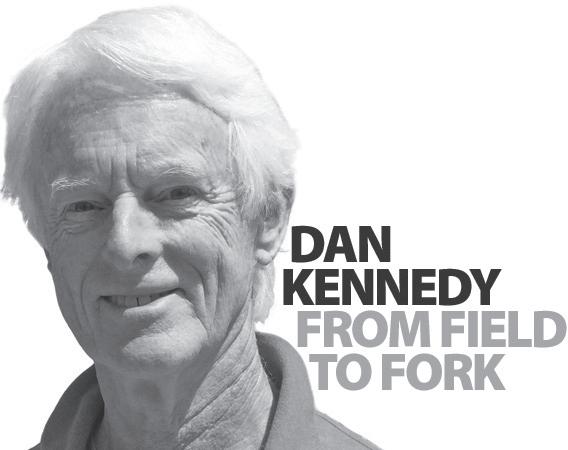
pricey as a stand-alone order to a wholesale grower. But Terra Firma buys in larger volume, and pays far less per unit. Such piggy-backed savings falls to the bottom line for the young farmers.
As we discussed this, Andrew took to his mobile again to find a pricing example on that day.
For kale seedlings, the cost was 5.2 cents apiece on an order of 10,000 or more.
But for a mere 1,000 to 2,000 seedlings, more their size of order, the price would be 19.2 cents each. They, in fact, now grow seedlings in their greenhouse.
Then there’s nature
costing them money on the bottom line.
A lot of birds overwinter around a nearby farm pond. As you can imagine, there’s not a lot for birds to eat in the cold months. The Andrews twins say they’ve shown up on mornings to find a flock has descended upon a favored crop, such as greens, eating the plants’ outer foliage and basically ruining it for potential sale.
Their days are long. They commute from an apartment they share in Davis and do it all themselves.
Besides their advantageous microclimate, they pointed out to another edge that they’re proud of. If they want lettuce for the Wednesday afternoon Davis Farmers Market, they can pick it that morning. It’s the apex definition of fresh.
What’s the vision, or is there one yet? It’s still to be determined, they said. Whether it makes sense to hire an employee is a question that’s still out there. But right now the focus is on the near future. I’d seen second-picks of broccoli, handsome turnips, and tasty fennel coming along in the rows with irrigation lines. Spring is just ahead. And there’s that weeding thing, which surely will arise when the weather warms. — Dan Kennedy has a long history with local food and the people who provide it to their communities. He serves on the Davis Farmers Market Board of Directors.
Daughter-in-law
Sarah printed out a menu for the cocktails she was prepared to make to order as part of a Big Birthday celebration. Our extended family had gathered for the occasion in a rented house in Fort Bragg, windows looking out over the beautiful Mendo coastline. Son Jakob (Sarah’s spouse) is a craft brewer and Mom (me) is a wine writer, but the most popular drinks that weekend were the cocktails.
You’ve probably seen recent articles bemoaning the fact that wine sales are down, largely thanks to young people, who prefer craft beer and (often elaborate) cocktails. Experts ponder the reasons, but with the allure of a Kir Violette (prosecco and crème de violette) or a Paper Plane (bourbon, amaro nonino, aperol, lime juice) or Jakob’s Probability Cloud (hazy IPA), “a glass of red” sounds a bit pedestrian.
What you often don’t find out until you’re well into the “young people aren’t drinking wine” pieces is that the sales drop applies mostly to Big Wine and not to the sort of wine I’m always advocating here. Young(ish) folk, it seems,
who happily consume craft beer and cocktails, are adventurous drinkers. They seem to like storied drinks of all sorts, including wine, especially those made with good ingredients — and no bad ones.
I’m hoping they celebrate the variety of their choices and try to choose responsibly. And if this dips into Big Wine’s pockets (and Big Beer and Big Liquor) I’m not too concerned with the sales numbers.
I’ve been writing for a decade about small-production, natural wines and winemakers — European, South African, Latin American and domestic. Granted, the wines are more expensive than ubiquitous brands, and this, too, is a factor in choosing a drink, especially in a restaurant, where a tall herbinfused cocktail can cost the same or a bit less (and a pint of stout a lot less) than a 4- or 5-ounce wine pour.
And good domestic wines can cost significantly more than imports. Many European wines come from vineyards cultivated for hundreds of years and kept in the family or community. Contrast this to the relatively later-comers in this country and the general tendency of our young not to follow in the footsteps of their parents. Vineyards are sold, land prices rise.
The prohibitive cost of California land now means that most up-and-coming winemakers own none. They must lease it or arrange to buy grapes from vineyards cultivated to their standards. Workarounds include picking from abandoned vineyards and from vineyards that are failing/flailing. They sometimes trade rehabilitating the vineyards for access to the harvest.
Chris Brockway of Broc Cellars (Berkeley) and Kenny Likitprakong of Hobo (Napa), for example, are known as folks to call if you find abandoned vines. Megan Bell of Margins Wine (Watsonville) sees as part of her mission to work with small growers and help them switch from conventional to organic
farming “by providing guidance as well as assurance that the grapes will have a home.”
Bryn and Jeffry Ellsworth (Ellsworth Wines in the Sierra Foothills) volunteer to work vineyards in exchange for grapes; at one point they were given a 1.5-acre Penn Valley (west of Grass Valley) vineyard to work completely on their own — and, of course, to make wine with the grapes. Like Megan Bell, they do everything themselves — tending the vines, picking the grapes, (foot)crushing them, fermenting them, and bottling. Also like Megan, they’re “naturalistas” (as some Europeans call natural winemakers), eschewing manipulation and additives.
“Our goal in every vineyard is to leave it better than we found it...we do not use fertilizers, herbicides or pesticides, synthetic or organic, in our vineyards ... At the end of the day it’s a ... true expression of what is here.” In other words, these are wines with “terroir,” a real sense of the land, climate, soil — and the passion of the makers.
Bryn and Jeffry are relative newcomers with just a couple of vintages behind
Enterprise staff
Davis School for Independent Study named Haley Reinl as Rotary student of the month for January.
“It is my pleasure to recognize Haley Reinl as Davis Sunrise Rotary Student of the Month for January 2023,” teacher Christne Easton said.
“Haley is a concurrent student at Davis School for
Independent Study — Virtual Academy and at Davis Senior High School. At DSIS Virtual Academy, Haley has demonstrated an excellent work ethic as a student and community leader. Haley is flexible and cooperative, learning and succeeding in a new online, learning platform
‘Edgenuity’ for her Social
Studies, English and Art classes. She excels and works well with others in her Zoology and Botany class at Davis High.
“Last semester, she devoted additional time to Veterans of America and organizing the bookshelves in the DSIS library. Haley has faced adversity and overcome challenges. She was diagnosed with an illness that has severely limited her participation in
sports and additional extra curricular activities. In her free time, she finds inspiration and enjoyment in reading, creative writing, and hanging out with friends. Yet Haley’s challenges have only strengthened her determination and resilience. She’s a true role model and a pleasure to know and work with.
The staff at DSIS are truly proud of her accomplishments and honored to
them. I picked up (at The Pip, $29) a bottle of their 2020 Sierra Foothills Red Table Wine, which is a blend of mostly merlot and cab with a dollop of cab franc. A really lovely, bright. and fruit-filled wine, it tastes of dark berries and plum with good herbiness. For its mere 12.9% alcohol, it’s surprisingly lush and sturdy — it stood up beautifully to a hearty red sauce with wild mushrooms and Sicilian sausage.
Natural wines can be a challenge to drinkers used to very fruit-forward, highalcohol California wines, especially since their very naturalness brings with it some volatility and more variation than their muchmanipulated siblings.
Amy, proprietor of The Pip, talks about the “natty” quality of many natural wines (I have a higher tolerance/appreciation for natty than she does), but this Ellsworth blend is completely approachable and easy — yet still interesting, elegant and wellstructured.
While being “familiar,” in part because of the familiar grapes, it also has a personality all its own, not surprising when you find out that the vineyards are high-elevation and
have Haley as part of the DSIS family.”
Ithaca College named Jordan Hayakawa of Davis to its fall 2022 Dean’s List.
Founded in 1892 in upstate New York, Ithaca College is a residential college dedicated to building knowledge and confidence through a continuous cycle of theory, practice and performance. Home to some 5,200 students, the college offers more than 70 degree programs. Students, faculty and staff at Ithaca College create an
dry-farmed and the wines aged in used oak. I look forward to trying Ellsworth’s other wines, like their zinfandel/syrah blend. An added attraction: the bottles are lightweight (giving them a smaller carbon footprint) and have labels that look like miniature paintings. They look great on the table. Try the merlot/cab blend for a memorable introduction to the natural wine world.
Last week I wrote about Davis’ latest wine source — Wines in Tandem at 222 D St., next to the Pence Gallery. They’re having a grand opening this weekend — Friday through Sunday, noon to 5 p.m. — with tastes and discounts and general merriment. Stop by, meet founder Ryan Crosbie, drink delicious, unusual wine, and hang out with fellow wine lovers.
I’m predicting that
Wines in Tandem customers will span generations and enjoy — even in the face of all our great homegrown brews and craft cocktails — the small-production wines Ryan brings to downtown Davis.
— Reach Susana Leonardi at vinosusana@ gmail.com. Comment on this column at www.
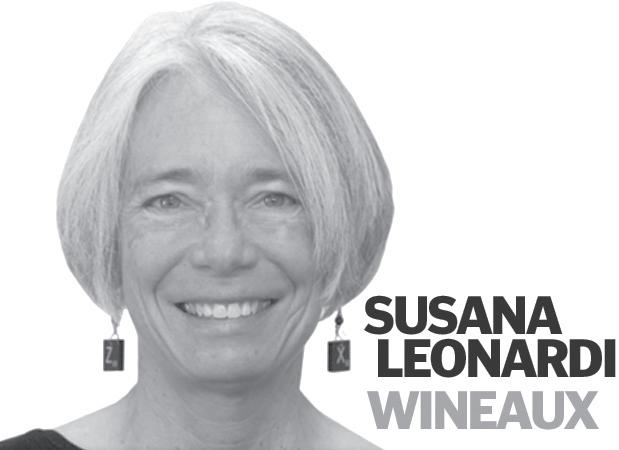
active, inclusive community anchored in a keen desire to make a difference in the local community and the broader world. The college is consistently ranked as one of the nation’s top producers of Fulbright scholars, one of the most LGBTQ+ friendly schools in the country, and one of the top 10 colleges in the Northeast.
— Do you know of someone who has won an award or accomplished something noteworthy? Email it to newsroom@davisenterprise.net.





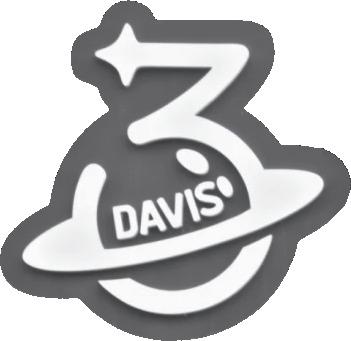





A calm breeze and warm air were present at Dobbins Stadium Sunday afternoon as the UC Davis baseball team captured a 20-4 victory over the Utah Valley University Wolverines.
The win allowed the Aggies to split its fourgame series with the Wolverines 2-2.
From a nine-run inning to a grand slam, it was perfect weather for the conclusion of an intense weekend of action between the two baseball clubs.
After Utah Valley went down in the top of the first inning, the Aggies made a lot of noise in the bottom of the frame.
Damian Stone, a junior left fielder, singled and stole second base. Then sophomore center fielder Mark Wolbert smacked a single up the middle of the field in which Stone showed track-like speed to round third and score home. The RBI was Wolbert’s first of six on the day and started an incredible nine-runinning for the Aggies.

Then junior second baseman Alex Gouveia from a single and getting on base. The Aggies had Wolbert at second, Gouveia at first and all Utah Valley needed was one more out. However, a wild pitch from Utah Valley’s Luke McCollough to catcher James Williams III would prove otherwise. As Wolbert and Gouveia would seize the opportunity, and each steal a base.
Then UCD suddenly had two runners in scoring position. Williams III took full advantage of the situation. He thwacked a double down to right field and brought the runners home. Now up 3-0, the Aggies set the tone for the rest of the contest.
“Hitting is contagious and it certainly was today,” said Aggies head coach Tommy Nicholson. The Aggies virus-esque hitting continued throughout the rest of the first and so did the Wolverines wild pitching.
Further into the inning, UCD would obtain two additional RBIs, get a 5-0 lead, with runners on second and third. All before completing its batter rotation. Stone returned to the plate and kept the momentum he started by hitting a single for an RBI. After a walk and a stolen base, the Aggies now occupied the diamond. Wolbert stepped up to the
Enterprise staff

LA JOLLA — Evanne Turner and Tova Sabel combined for 44 points, as the UC Davis women’s basketball team made a statement with a 72-49 victory over UC San Diego to leapfrog the Tritons in the Big West Conference standings.
For the first time since early November, UC Davis (9-6 in the Big West, 13-12 overall) will enjoy an overall record above the .500 mark.
With the convincing victory on Monday afternoon, the Aggies currently sit in a tie for fourth place in the conference as the regular season nears its end.
UC Davis was dominant from start to finish in a game where it couldn’t seem to miss from the perimeter.
plate, with bases loaded, and delivered a double down right field. Which brought all three-runners home and cemented the nine-run inning before Utah Valley got its final out.
“Nothing like a lead to calm you down and relax,” said Nicholson. Nicholson adds how the batters struggled to get into rhythm earlier in the series, but the ability to relax and be themselves contributed to Sunday’s performance.
After the first- inning concluded, the second and third would go scoreless between the teams.
The Aggies would go on to score a total of four runs between the fourth and fifth innings to make their lead 13-0. Williams III, Stone and junior first baseman Theo Forshey had RBIs.
While the Aggies pitching and fielding kept Utah Valley scoreless until the sixth frame, freshman pitcher Alejandro Huezo tallied eight strikeouts over four innings, but gave up three runs and all in the sixth.
The Wolverines started the top of the sixth with a home run from center fielder Patrick Mills. Huezo struckout Utah Valley’s next two batters.
However, after a single, junior-shortstop Garrett Broussard would hit another homer for the Wolverines. That brought him and catcher Westen Penninger home. With a little run the Wolverines made the score 13-3 before UCD got its third out.
The Aggies went scoreless in the bottom of the sixth and kept the Wolverines scoreless at the top of seventh.
But, after the seventh inning stretch magic happened, three Aggie batters
walked in a row.
Leading to another bases-loaded situation and only one out. That’s when junior designated-hitter Jack Gallagher smacked a grand slam out of the park, extending the Aggies’ lead to 17-3.
“It was really big for the hitter’s confidence… and I know they have a lot more confidence than what they were showing the first few games,” said Nicholson on the grand slam.
The seventh frame wrapped up and both teams would score in the eighth and set the score 20-4.
The Aggies had two home runs as part of their 18 hits in the game. An inside-the-park for an RBI courtesy of Wolbert, and one from Gouveia, who was specifically and efficient from the plate. He stepped up five times, smacked four hits and nabbed four total runs.
Gouveia went 4-for-5 for UCD. Wolbert and Stone went 3-for-5 each, Williams III and Theo Forshey had two hits each.
The Wolverines had 11 hits in the contest.
Aggie pitcher Alejandro Huezo picked up the win. He struck out eight Wolverines, walked none and gave up six hits.
Things are looking up for the Aggies and Nicholson as they’ve already captured a third of last year’s victories in a single weekend.
Now UCD shifts its focus on hosting the Santa Clara University Broncos. The first game is Friday at Dobbins Stadium at 2 p.m.
The Saturday and Sunday games are scheduled to start at 1 p.m.
— Gabriel Caraballo is a recent UC Davis graduate with a degree in communication.
The Aggies made 13 3-pointers in the contest,
with 10 of those shots coming from the hands of Turner and Sabel.
It was also quite an efficient shooting night as UC Davis shot 43.1 percent as a team and 40.6 percent from beyond the arc. The Aggies took care of the basketball and recorded a season-low nine turnovers, but brought some serious pressure on the defensive end, forcing 20 Triton turnovers.
Turner ascended to 16th place on the UC Davis women’s basketball all-time scoring list following her 22-point showing in La Jolla. The junior guard matched a career-high six 3-pointers while going 8-of-13 from the field.
Matching her on the offensive end was Sabel,
who also dropped 22 points on the day. Her four 3-pointers equaled her best outside shooting display of the year.
After receiving interest from across the country, the Sacramento River Cats, proud Triple-A affiliate of the San Francisco Giants, are thrilled to announce Zack Bayrouty as the new voice of the franchise.
Bayrouty replaces longtime River Cats announcer Johnny Doskow, who accepted a position with the Oakland Athletics in January.
Bayrouty made his Major League debut in Oakland on Sept. 3, 2019, calling the game between the A’s and Los Angeles Angels.
From Page B6
the third year of a four-year transition from Division II to Division I and is ineligible for the conference title this season, had high praise for the Aggie effort.
“Davis really impacted us with their defense and their physicality,” said Olen.
The Aggies now enter the stretch run with four games remaining, two on the road and the final two at home. Things won’t get any easier, but at least UCD has
its fate in its own hands as far as gaining one of those coveted first-round byes. Depending on what sort of help they get along the way, that may mean the Aggies have to win out to earn a bye.
Even if they finish seventh, they’ll still be in the tournament, but will have to win four straight games to claim the title and earn the NCAA bid.
The first test comes Thursday at surging Cal State Fullerton, followed by a Saturday road date at last-place Cal Poly.
From Page B6
meet, visit www.cifstate. org.

Sam Reising (154) took eighth place and Ian Greenway (184) finished with a 4-2 record.
Reising won his first match of the Masters by pin in the first round, and second match by a 9-5 decision. Then the Blue Devil fell in his third match by a 9-0 major decision. He responded in the loser’s bracket by posting a 5-3 decision. His season ended in the following
round with a loss by a 6-0 decision.
Greenway lost his first match but won the next two before losing by pin.
The Blue Devils took 51st place with 15 points. Oakdale won the team title with 273.5 points. Vacaville was second at 216.5 and Del Oro third at 169 points.
Enterprise staff
Two Davis High wrestlers, both girls, extended their season for one more week.
Avangeline Turner (150-pounds) and Andrea Gonzalez (111) took second and fourth places in their respective weight classes at the CIF Sac-Joaquin Section Masters Wrestling Tournament at Stockton Arena on Saturday.
The duo and the top six placers now advance to the California Interscholastic Federation State Wrestling Championships, which will be held at Mechanics Bank Arena in Bakersfield starting Thursday through Saturday.
Turner, a junior, posted a 3-1 record in her weight class, won the first three matches by pins all in the first round to advance to the championship bout against Mikayla Lancaster from Gregori of Modesto. Lancaster pinned
Turner in the second round to win the title.
Gonzalez, also a junior, posted a 3-2 record at the Masters. Gonzalez won her first two matches by pin but lost a 12-7 decision, which dropped her into the loser’s bracket of the double-elimination tournament.
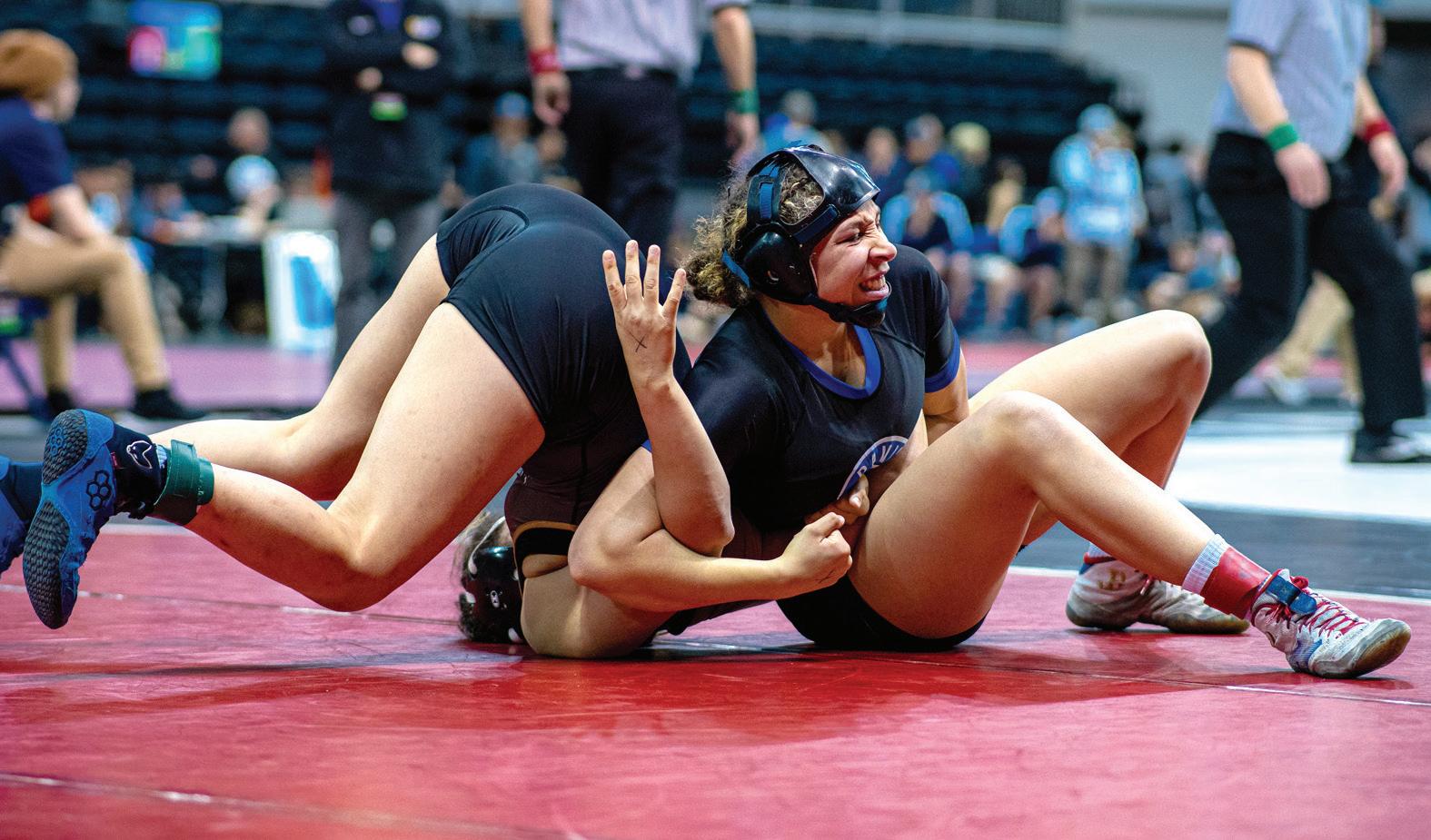
But Gonzalez won her fourth match by pin to advance to the third-place match against Turlock’s Heidi Judson. Judson escaped with a 6-4 decision.
The DHS girls were tied Chavez of Stockton for 12th place with 43 points.
Pitman of Turlock won the team title with 112 points, Del Oro second at 105.5 and Tokay of Lodi third at 68.
For more information on the state
Members of the Davis High boys soccer team shake hands after thumping Oak Ridge 5-0 in the CIF Sac-Joaquin Section Division I semifinal game at Ron and Mary Brown Stadium on Saturday. To view more photos, visit www.davisenterprise.com, click on the Sports tab and look for the story.
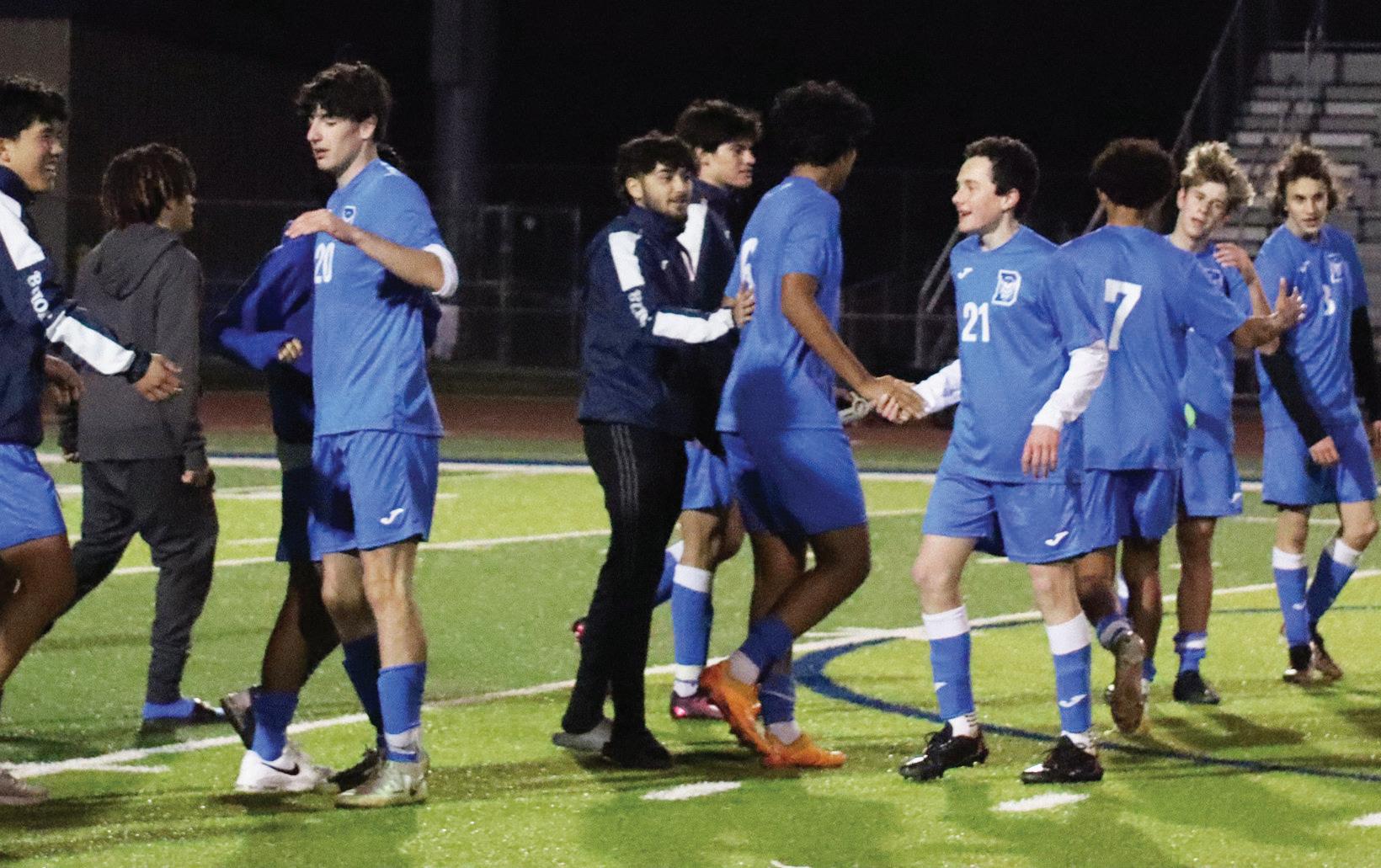
No sooner had the ball rested in his opponent’s net did Simon VacaLorenzi run away in a fury.
The Davis High boys soccer player, a senior forward, opened the scoring Saturday night against Oak Ridge in the Sac-Joaquin Section Division I soccer semifinal. He celebrated by sprinting to the corner arc and dancing the “Griddy.” A mob of delirious teammates, starters and backups alike, joined the flash mob during their 5-0 win.
Vaca-Lorenzi and JJ Guerra scored two goals apiece for Davis (18-0-2), which is ranked No. 2 in California and No. 3 in the nation, according to MaxPreps.
The top seed faces No. 2 Whitney (14-1-5) on Thursday at Cosumnes River College at 7 p.m. Davis will arrive in South Sacramento having won its three playoff games by a combined 13-0 score.
By reaching the section title game, Davis and Whitney have earned automatically berths into the California Interscholastic Federation Regional Soccer Championships. The playoff brackets are scheduled to be released on the CIF’s website — www.cifstate.org — on Sunday.

The finalists for the section title games in Divisions I through IV earn
Blue Devils head coach Alex Park watches his squad during the second half of Saturday’s D-I semifinal playoff game against Oak Ridge. Park and DHS are ranked No. 2 in California and No. 3 in the nation, according to MaxPreps’ website. On Thursday, Davis will play Whitney of Rocklin for the section’s D-I title. The two teams battled to a 3-3 tie in a preseason game in December.
a berth, while only the winners in D-V and D-VI advance to the regional playoffs.
The Blue Devils will be the first to point out: Their substance matches their flair.
“It’s the heart we have as a team — and not just from the starting 11,”Blue Devil senior defender Holt Klineberg said. “It’s everyone who can come off the bench and keep the intensity high. We have a great atmosphere and a great chemistry.”
As Davis enjoyed another command performance on its home field, one difference was striking.
High school football sternly discourages all expression. A touchdown celebration on the same DHS football venue would surely draw a parade of penalty flags. In contrast on Saturday, the soccer playoff referees put up boundaries with discretion.
The teams combined for six fouls and two yellow cards in the first half alone. Neither team drew a celebration penalty throughout.
To be fair, only one side had reason to celebrate.
The No. 5-seeded visitors from El Dorado Hills trailed 2-0 after 12 minutes. The Blue Devils dominated possession from kickoff to final whistle.
Davis nearly surrendered an owngoal after eight minutes. Moments
later, goalkeeper Declan Fee collided with a Trojan attacker and needed a minute to find his bearings. No Oak Ridge (11-3-4) threat arrived again until the second half, when the game was well out-of-reach.
The two-goal margin remained until the final seconds of the first half. Then came a defining sequence. It began with Klineberg winning possession deep in his own end.
The Blue Devils lacrosse standout then sprinted no fewer than 40 yards down the near sideline. He pushed the ball to Vaca-Lorenzi. A scoring chance beckoned. He returned serve to Klineberg, who found another teammate in perfect stride. Guerra’s left foot made the score 3-0.
Guerra is the most intriguing of the Blue Devils’ 15 seniors. He spent the previous two years on the Sacramento Republic’s junior squad.
Professional demands have given way to carefree revelry. He has no regrets. These Blue Devils throw team pizza parties and host the occasional axe-throwing night.
“I stopped playing the Republic, and I feel like it was a good choice,” he said. “I’m glad I’m with this team. It’s like a once-in-a-lifetime team. We hang out as a family, and we push each other on the field.”
— Follow Mark DeVaughn on Twitter: @OrangeMarkD.
There’s an old saying in sports that anyone can win on a good day, but that the great teams find a way to win even on their not-so-good days.
UC Davis proved the validity of that adage by taking a 76-66 Big West Conference men’s basketball win from UC San Diego Monday afternoon at the University Credit Union Center despite suffering through one of its worst shooting games of the season.
Before an enthusiastic holiday crowd of 1,688, the Aggies used a stellar defensive effort and contributions off the bench to overcome cold shooting and foul trouble to push their Big Sky record to 9-7 and stay alive for a first-round bye in the conference tournament that goes to the top six finishers in the regular season.
The Big West tournament runs from March 7-11 at the Dollar Loan Center in Henderson, Nev., with the winner advancing to the NCAA’s Big Dance.
With the win, the Aggies moved from seventh place into a tie for sixth with Long Beach State.
“It was a gutsy win by our guys,” said a clearly pleased Aggie head coach Jim Les.
“We were down a couple of men, had foul trouble and some guys were running on empty, but their resolve was very good. Our defensive intensity really carried us.”
TY Johnson, UCD’s second-leading scorer at 15.2 points a game, got in early foul trouble and played only 13 minutes while being held scoreless.
Picking up the slack was Leo DeBruhl, a 6-foot-2 sophomore out of Seattle, who has started several games in place of the injured Robby Beasley.
DeBruhl played standout defense while recording a double-double with 14 points and 10 rebounds, along with three assists.
Aggie guard Eli Pepper didn’t have his usual magical shooting touch, but still managed to reach his season average with 22 points, 18 of which came after intermission.
Kane Milling added 18 points for UCD, including a pair of free throws and a 3-point dagger down the stretch to kill any hope of a UCSD comeback.
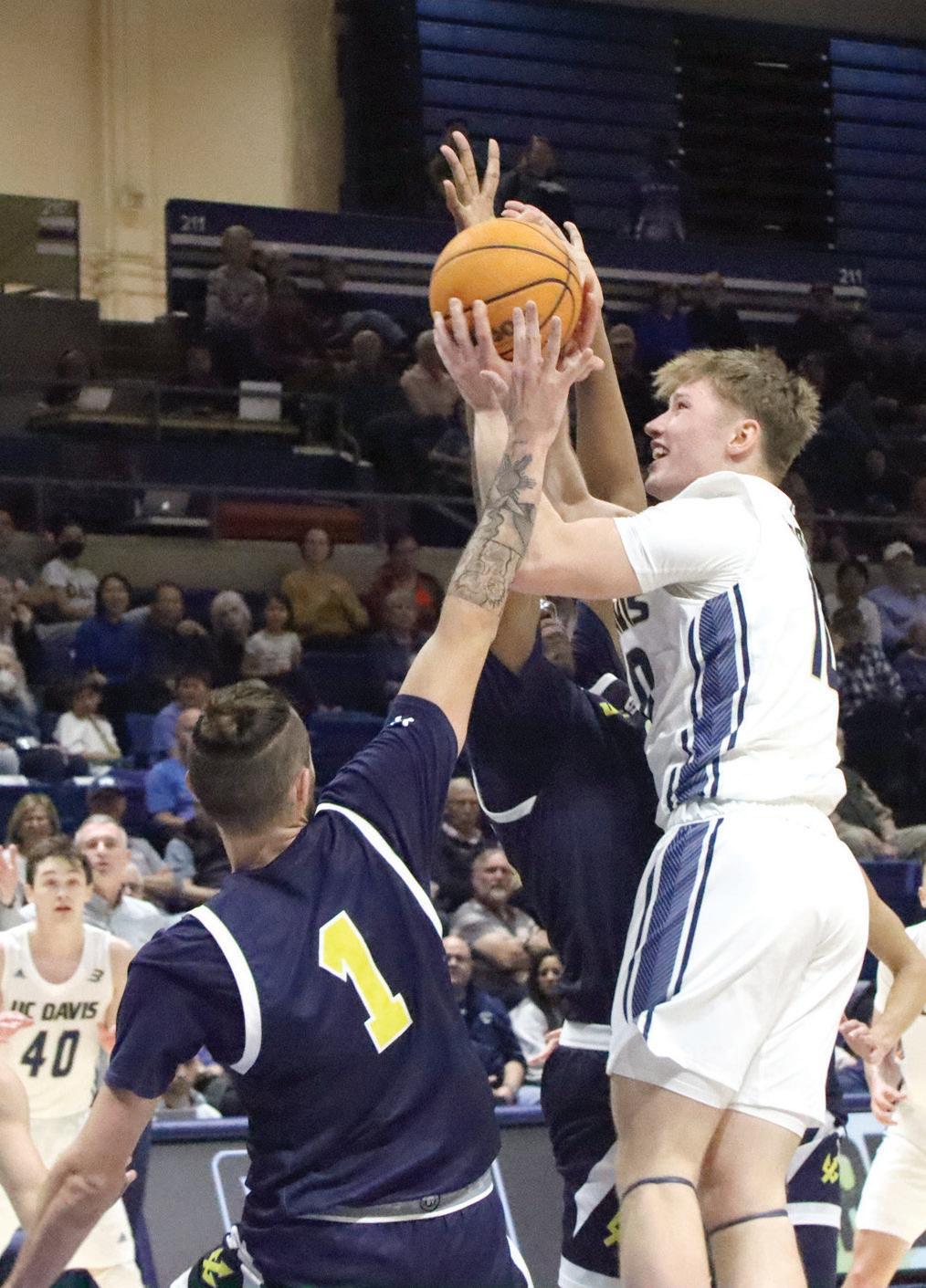
The Aggies hit just 39.7 percent from the floor, including 8 of 27 from 3-point range and missed 12 of 34 free throw attempts.
San Diego head coach Eric Olen, whose team is in